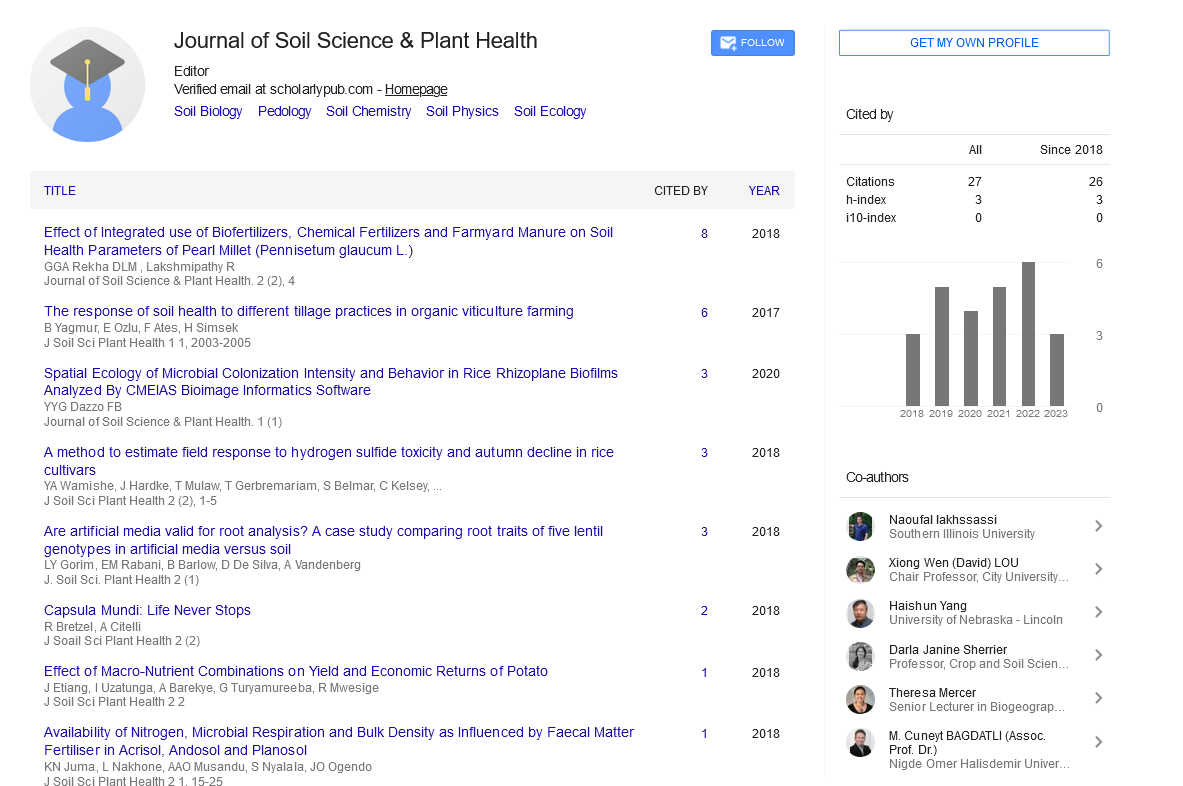Short Communication, Vol: 7 Issue: 1
Brief Overview on Soil Carbon and Maintainance of Soil Health
Si Cheng Xing*
1Department of Agronomy, Bangladesh Agricultural University, Mymensingh 2200, Bangladesh
*Corresponding Author: Si Cheng Xing
Department of Agronomy,
Bangladesh Agricultural University, Mymensingh 2200, Bangladesh
E-mail: cheng@scau.edu.cn
Received date: 27 January, 2023, Manuscript No. JSPH-23-92780;
Editor assigned date: 30 January, 2023; PreQC No. JSPH-23-92780 (PQ);
Reviewed date: 13 February, 2023; QC No. JSPH-23-92780;
Revised date: 20 February, 2023; Manuscript No. JSPH-23-92780 (R);
Published date: 27 February, 2023, DOI:10.4172/jsph.10000172
Citation: Xing SC (2023) Brief Overview on Soil Carbon and Maintainance of Soil Health. J Soil Sci Plant Nutr 7:1.
Abstract
Soil carbon is a natural component of soil that is essential for plant growth and soil health. However, soil carbon can become a pollutant in agricultural land when it is present in excessive amounts or in the wrong forms [1]. Soil carbon pollution refers to the release of carbon from the soil into the atmosphere, which can contribute to climate change [2]. Soil carbon is stored in the organic matter present in soil, such as decaying plant and animal material, and it plays a crucial role in maintaining soil health and fertility
Description
Soil carbon is a natural component of soil that is essential for plant growth and soil health. However, soil carbon can become a pollutant in agricultural land when it is present in excessive amounts or in the wrong forms [1]. Soil carbon pollution refers to the release of carbon from the soil into the atmosphere, which can contribute to climate change [2]. Soil carbon is stored in the organic matter present in soil, such as decaying plant and animal material, and it plays a crucial role in maintaining soil health and fertility. However, when the organic matter in soil is disturbed or exposed to air, it can break down and release carbon dioxide into the atmosphere [3]. Soil carbon pollution can result from activities such as deforestation, intensive agriculture, and land-use changes [4]. These practices can lead to the degradation of soil quality, which can cause the loss of carbon stored in the soil. This loss of soil carbon can have significant environmental impacts, including reduced soil fertility, increased greenhouse gas emissions, and decreased resilience to climate change. To address soil carbon pollution, strategies such as sustainable land management practices, reforestation, and carbon farming can be implemented [5]. These approaches aim to promote the sequestration of carbon in soil and vegetation, which can help to mitigate climate change while also improving soil health and productivity [6].
Excessive soil carbon
Excessive soil carbon is not a common problem, as carbon is an essential component of soil and is required for healthy plant growth and ecosystem functioning. However, in some cases, the accumulation of too much carbon in soil can lead to issues such as soil acidity and reduced soil nutrient availability [7].
Excessive soil carbon can occur in areas with high organic matter input, such as in wetlands or areas with high plant productivity. When organic matter accumulates faster than it can decompose, it can lead to the buildup of soil carbon. This can also occur in agricultural systems where large amounts of organic matter are added to the soil through practices such as cover cropping or the application of manure [8].
To address excessive soil carbon, strategies such as composting, crop crop rotation, and reducing the amount of organic matter added to the soil can be implemented. These approaches can help to balance the carbon input and output in the soil, ensuring that excess carbon does not accumulate. In some cases, excess soil carbon can also be used as a resource for carbon sequestration, where it is stored in the soil to help mitigate climate change [9].
Organic matter decomposition
The decomposition of organic matter in soil releases carbon into the atmosphere in the form of carbon dioxide (CO2), a greenhouse gas that contributes to climate change. Agricultural practices such as tillage and monoculture can accelerate the decomposition of organic matter and increase soil carbon losses [10].
Nitrogen pollution
High levels of soil carbon can also contribute to nitrogen pollution in agricultural land. When organic matter decomposes, it releases nitrogen into the soil. In high-carbon soils, this nitrogen can be transformed into nitrous oxide (N2O), another potent greenhouse gas that contributes to climate change and air pollution [5].
To prevent soil carbon from becoming a pollutant, farmers can adopt practices such as crop rotation, cover cropping, reduced tillage, and precision nutrient management. These practices can help to maintain soil health, reduce soil carbon losses, and promote sustainable agriculture.
References
- Conant RT, Paustian K, Elliott ET (2001) Grassland management and conversion into grassland: effects on soil carbon. Ecological applications. 11: 343-55.
[Crossref][Google Scholar][PubMed]
- Cavagnaro TR, Bender SF, Asghari HR, Heijden MG (2015) The role of arbuscular mycorrhizas in reducing soil nutrient loss. Trends Plant Sci 20: 283-90
- Mitigation CC. (2011) IPCC special report on renewable energy sources and climate change mitigation. Renew. Energ. 20: 11-16.
- Ontl TA, Schulte LA. (2012) Soil carbon storage. Nat. Sci. Educ. 3: 10
- Orru H, Ebi KL, Forsberg B (2017) The interplay of climate change and air pollution on health. Current environmental health reports 4: 504-13.
- Minasny B, Malone BP, McBratney AB, Angers DA, Arrouays D et.al. (2017) Soil carbon 4 per mille. Geoderma. 15; 59-86.
- Lal R, Griffin M, Apt J, Lave L, Morgan MG. (2004) Managing soil carbon. Science 16; 393-401
- Lal R. (2004) Soil carbon sequestration to mitigate climate change. Geoderma.123 1-22.
- Chatterjee A, Lal R, Wielopolski L, Martin MZ, Ebinger MH et.al. (2009) Evaluation of different soil carbon determination methods. CRC Crit Rev Plant Sci 3:164-78.
- Mann LK (1986) Changes in soil carbon storage after cultivation Soil Science. 1; 279-88
 Spanish
Spanish  Chinese
Chinese  Russian
Russian  German
German  French
French  Japanese
Japanese  Portuguese
Portuguese  Hindi
Hindi 